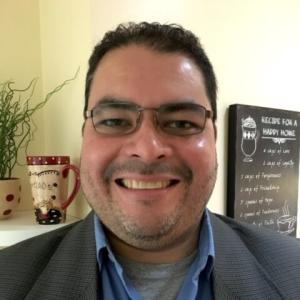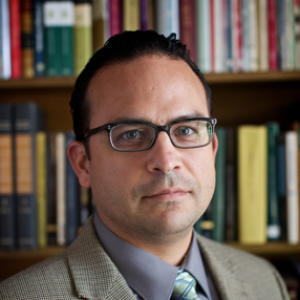Resources

Our seminary recently hosted a symposium on beauty. For the occasion, I performed a musical interpretation of a digital art piece entitled “By night and by day,” part of a larger composite of cloud themes depicting God’s presence with his people by artist Sarah Bernhardt. I explored a range of sonorities on the double bass to tell the Exodus story, to depict God’s leading of Israel out of Egypt by a pillar of cloud by day and of fire by night. To guide me in my portrayal of the theme of divine presence, I composed a musical setting based on a melody from a Latin American song entitled El Señor es mi luz (The Lord is My Light) based on Psalm 27. The psalm speaks of Israel’s trust in the Lord’s protection from adversaries who assail her during her earthly pilgrimage. The psalmist also sings of Israel’s eschatological hope to dwell in the house of the Lord forever and behold his beauty in his temple. In my composition I employed word painting, a technique used in sixteenth century music to match a concept in a written text with a corresponding musical effect. The following description of the flow of the piece explains how I used the range of the double bass to communicate various aspects of the biblical story. High pitch harmonics placing fingers over strings The piece begins with a variation of the psalm melody using high pitch harmonics, which are achieved by touching the strings without pressing them. This technique communicates a sense of God’s presence on high as Israel prepares to cross the sea. It is a calming presence; God is in control. Energetic tremolos with the bow The harmonics are followed by energetic tremolos made with rapid bow movements to the chorus of the hymn. This technique expresses the tumultuous movement of God’s people away from their enemies, with the pillars of fire and cloud ahead of them as they rapidly (and perhaps a bit anxiously) make their way through the great waters. Hitting strings with the bow’s wood (col legno) to introduce the theme (chorus) To express Israel’s proximity to the waters of salvation, I play the psalm melody with the back of the wooden bow (col legno technique), evoking images of drops of water falling on or sprinkling faces and bodies as people prepare to cross the sea. Flowing lyrical version of the theme with the bow (verse, stanza) Then I play a flowing lyrical version of the theme with the bow, depicting Israel’s safe arrival to the Promised land, which anticipates the final beatific vision of God’s people in his presence. Festive plucking to a Cuban guaracha Plucking the strings (pizzicato), I play a Cuban guaracha (salsa) rhythm based on the song’s chord progression to express the mood of eschatological fiesta after the people’s safe passage through turbulent waters into the Promised Land. Playing a Panamanian tamborito rhythm percussively on the wood of the bass… Finally, I sing the hymn’s chorus in Spanish while tapping the top wooden shoulders of the instrument to a tamborito Panamanian rhythmic pattern, using the bass in a percussive way. So, what makes the piece a Latin American interpretation? The most obvious element is the use of a psalm in the Spanish language. But the more interesting ones are the plucking of strings to a Cuban Guaracha (salsa) and the drumming of the wood on the shoulder of the bass to a Panamanian tamborito. But why infuse the text with a Latin American spin? Here the context of the performance matters. I have performed this piece in three settings with similar audiences—predominantly White, monolingual (English), mid-Western church audiences in the United States. By incorporating these elements in the performance, I am inviting the audience to imagine a world in which the biblical story is told, heard, and sung through Latino/a eyes. I am using music as a gentle challenge to see the biblical story in the context of the catholicity or universality of the church, which is a church of people from many ethnicities, languages, and nations. I am also raising awareness about the presence of forgotten Latino/a neighbors whose voices are often not heard, who crave for belonging, justice, and the psalmist’s hope in God’s deliverance. By foregrounding these elements into the piece, my double bass functions as an extension of the Latino teacher-performer’s own identity as a proclaimer of God’s story, a bearer of an inclusive catholicity, and a herald of hospitality, justice, and hope.

[caption id="attachment_250814" align="alignleft" width="335"] Gesture drawing, charcoal on newsprint[/caption] I remember sitting beside a piece of blank newsprint, clutching a twig of willow charcoal, looking at a table covered in all sorts of objects—a shiny chrome blender base, a bleached cow’s skull, yards of loosely draped fabric, old pieces of driftwood, a single ice skate and various pots, pans, and kitchen bowls. We were doing “gesture drawing” and my task was to use my charcoal quickly and loosely to sketch the vaguest and most general shapes I was seeing. I had to look beyond the detail of the objects to the ways in which overall shapes emerged from the play of dark and light. My attempts looked ghostly and out of focus, primitive and unskilled. The truth was that I had never done this before, and I felt completely out of my depth. I was taking a drawing class in our Fine Arts department. This was my first undergraduate class in more than twenty years, and I was taking it for credit. I registered as a student at my own institution, going through a registration process where I was even asked to produce my high school transcripts. And here I was, sitting around the table with my charcoal twig and my newsprint along with the other students in the class, completely out of my comfort zone, remembering what it was like to be learning as an undergrad. I decided to take this course because I was becoming increasingly interested in the creative process and the ways in which creative expression could function to connect students with complex ideas and abstract notions. But in exploring this creative entry point, I also wanted to remember what it was like to be coming at these issues as a student and to be learning about things that required one stepping beyond one’s usual range of experience and expertise. A drawing class was something I hoped would improve my drawing, but also allow me to consider with more empathy the experience of students in my classes who encounter challenging ideas and practices all the time. I learned a lot in this drawing class. I learned the difference between drawing what you see and drawing what you think. I learned that the creative process is often about following one’s nose, taking cues from what is in front of you and then taking the next step. I learned that inspiration often happens in hindsight, arising from consistent and sometimes less than inspiring routines. And I was reminded that learning involves taking risks and being vulnerable, ideally with the support of others around you. In my own classes, I include a lot of creative expressions of religious ideas and beliefs from the history of art and literature. I have always found these examples invaluable as ways of further illuminating what can otherwise seem counterintuitive and elusive notions. Sometimes, even for the cultural Christian, notions of incarnation, sacred mystery, and ineffability, for example, can appear both overly familiar and bewilderingly abstract. Creative expressions from the tradition can serve to span the distance between ancient, paradoxical notions and provide a location for ideas to play out in connection with more familiar, contemporary experiences. And yet, even the greatest work of art, the greatest masters of Western culture, from the past and present, can sometimes fail to bridge the gap. Sometimes connecting what is counter-intuitive to what is creative means taking a risk. It means being out of one’s depth and feeling one’s way forward, exploring the link between mystery and possibility. My attempts at gesture drawing were disconcerting, for sure, but in the end, they proved to be quite liberating. I had to let go of my preconceptions of what constituted “good art,” to quiet my internal art critic and trust my eye and my arm to do the work. I was forced to draw what I saw rather than draw what I had in mind. Stepping out of my comfort zone meant discovering new ways of seeing and new ways of doing. I could see that taking creative risks had the potential to open richer veins of insight and to reveal the invisible limitations of convention and culture that can sometimes limit inquiry and stifle growth. But does this exercise work in the other direction? Drawing what one sees rather than what one thinks is one thing, but what about the reverse? What happens when we draw what we have in mind and turn this idea into something others can see? A simple exercise I have used to connect the abstract with the creative involves asking students to draw the concept of belief. I ask them to draw something that doesn’t easily translate to a discrete object in the world. In effect, I’m asking the students the impossible task of giving a complex, abstract idea discrete and specific form. Everyone knows what belief is, but what does it look like? While the results can be clever and are often surprising, they also reveal how obscure and unfamiliar the term was from the beginning. Drawing an abstract concept involves being creative, for sure, but it also means committing to something specific, making choices about what to put on the page versus what to leave out or unaddressed. Every picture is but a gesture of the totality. While, a single picture is always a limited account of a larger idea, when the resulting pictures from the class are gathered, a wonderful richness emerges, still fuzzy around the edges, still indistinct and relatively unformed and yet collectively, they are evocative, rich, and real. In this way, drawing involves embodying an idea, giving it a certain kind of flesh and form in ways that depart from the goals and achievements of writing alone. It is not that a picture tells a thousand words so much as pictures and creative expressions have the capacity to speak differently. The vividness of this creative act, the grappling with impossibility and the inspiration of a collective perspective prompts a learning journey that I view with renewed respect as deeply creative, slightly unnerving, and open to immense possibility.

It is no secret that the arts are powerful tools that can be used in any classroom to challenge, liberate, expand, complicate, and even heal aspects of our educational practices. The visual arts, in particular, not only allow us to connect in deeper ways with the content and context of our studies but can also function as a portal to what is hidden in our deepest recesses in embodied, striking, and visceral ways. From rage to grief to wonder and joy, the arts help us access emotions and educate our affections while inspiring us to resist, denounce, agitate, connect, conjure, and generate tools for speculative imagination, for integration of embodied and intellectual knowledge for the healing of all our relations. As a site for world-making, art lends itself to dreaming, rehearsing, and choreographing new possibilities of being and acting in the world. Artists and works are poised with the capacity to enhance our understanding of how historical and cultural amalgamations circulate our bodies, shape our culture, and inform our experiences, while also offering opportunities to assess and integrate multimodal processes of learning. What follows is a series of suggestions on how to bring the arts into the classroom to activate and enrich multimodal learning. When I am presenting an artwork within the context of classes in art and religion, I like to begin by providing historical information based on my previous research of the work. I find the work’s curatorial files which, depending on the artist, are broadly available online. Many contemporary artists use their own websites as archives of works, exhibitions, ephemera, press clippings, etc., so be sure to check those as well. Then I consult chapters, articles, catalogues, and reference works which provide context for the creation and reception of that particular artwork.[i] I also provide the artist’s full name, the work’s title and date, the collection to which it now belongs, how it was acquired, and how the museum or gallery’s curatorial practices participate (or don’t) in “unlearning and changing the base of colonialism in the concepts of private property, Manifest Destiny,… Eurocentrism, Cartesian dualism, heteropatriarchy, capitalism, positivism, sexism, racism, individualism, extraction, classism, violence, and control,” as Wanda Nanibush, the assistant curator of Canadian and Indigenous Art at the Art Gallery of Ontario, puts it. The goal is to deepen and expand the experience of engagement with the works—not so much to define, constrain, or limit the contours of interpretation. In other words, the contextual information we offer on any creative work should not limit the personal connections, emotional reverberations, and embodied experiences that teacher-learners may develop with the work. Beyond the artist’s and work’s contexts, I ask teacher-learners to describe in detail what they see and what they understand. For example, if I share a painting, I ask them to describe the color, contours, textures, contrast, movement, proportion, composition, medium, size, dimensions, and how the lines appear in relationship to one another. This step reveals to us how we have been conditioned to take in a lot of images hastily, spending a very short amount of time looking, identifying, and savoring what the works are doing, and how the textures, colors, and rhythms of the composition have been carefully arranged by artists to elicit responses in us. Only after exhausting our capacities for naming what is in front of us, do I ask teacher-learners to progress in the interpretation of “what is” to “what it might mean.” We often claim that artworks mean something without carefully tracing for our class participants where these meanings are visually located or where they originated within the work. The last question I engage with is the “so what?” that Gilda Williams proposes in How to Write About Contemporary Art.[ii] What are the echoes for the context of our class? How does it invite us to look at our subject and discussions differently? How does it open up a space for the poetic to guide and allow us to access our deepest, sometimes hidden, recesses? Works of art are powerful in connecting us to our emotions, in helping us understand what it means to be human, to be whole, to be here. As theological educators who are laying out the blueprints for sacred, embodied, planetary change, we must remember to have the arts in our toolboxes. The arts are never far away from what matters most in life. Artistic productions participate in decolonial efforts—are capable of doing what Macarena Gómez-Barris names as “the erosion of the extractive gaze” while “affirming the diversity that resides within the matrix of coloniality.”[iii] As antidotes to Empire, visual arts are sites of subversion that promote imagining and shaping into being other emergent worlds. They also require from us, as Indigenous Brazilian thinker Ailton Krenak puts it, an acknowledgement that we are co-responsible for maintaining our capacity and responsibility to keep the dreams of our ancestors alive.[iv] As apertures into worlds of the not yet, artworks also welcome wonder, openness, diversity, reciprocity. Allowing a careful looking, engaging, and sensing what the works are activating emotionally, intellectually, and spiritually in us is generative way to amplify learning in our classrooms. Part II of this series will provide practical examples of engagement with artworks. Available April 27, 2022. [i] A helpful resource for helping in the design of the experience with works of art is Teaching at the Museum: Interpretation as Experience by Rikak Burnham and Elliott Kai-Kee, published by the J. Paul Getty Museum in 2014. [ii] Gilda Williams, How to Write About Contemporary Art (New York, NY: Thames & Hudson, 2014). [iii] Macarena Gómez-Barris, The Extractive Zone: Social Ecologies and Decolonial Perspectives (Durham, NC: Duke University Press, 2017), 133. [iv]Ailton Krenak, Ideias pra Adiar o fim do Mundo (São Paulo: Companhia das Letras, 2019), 47.

The social justice issue that I have consistently raised in my biblical exegesis courses has been US immigration. As I tell my students—mostly white middle-class Protestants fixed on parish ministry—engaging this topic in a sermon will likely incite some criticism from parishioners or even set in motion a premature resignation. Despite my school’s borderlands location and the exilic content of the Hebrew Bible, pivoting to the topic of US immigration in a biblical exegesis course cannot be done haphazardly. In terms of texts, I find that Genesis (12–50), Exodus, Psalms 120–134, Second Isaiah (40–55) and Lamentations are especially apt for engaging this complex sociopolitical topic. What is unavoidable in these texts are stories about people on the move because of famine, jealousy, conquest, or faith—to name just a few. Yet still, connecting these biblical stories to the lived experiences of migrants in places like the US-Mexico border is by no means a linear process. No matter how convinced I am that Abram’s journey from the Ur of the Chaldeans to the land of Canaan (Gen 11:31) is a migration story, in order to bring my students along I must confront the assumptions that inform their understanding of migration. A common assumption they often have about migration and by extension immigration is that both phenomena represent a social problem or challenge. At the source of this assumption is indeed not an ancient notion of migration but rather their nation-state formation. By contextualizing the latter, students discover that the problems most associated with migration and immigration in US dominant society—like border crossers as “illegal,” economic strains, cultural threats, and spreaders of disease—stem from Western nationalist forms of inclusion and exclusion. After discovering their own nation-state biases about immigrants, I find it easier to shift to the theme of migration in the biblical text, contrasting along the way the ancient assumptions that likely informed it. As opposed to nationalist thinking, the biblical text often starts with the assumption that humans are free to move and that this movement constitutes an act of faith rather than a crime. Emphasizing the freedom of movement and the faith that accompanies it in the biblical text, I then pivot to US immigration and the sociopolitical injustices produced by the nation-state’s control of human mobility. Though migration studies, forced migration studies, and refugee studies are useful resources, their approach to immigration is often based entirely on the modern concept of the nation-state and hence tend to view borders, citizenship, and state sovereignty not as human constructs but as natural to our earthly existence. This nationalist-centric agenda can also be transferred unwittingly over to the biblical commentary material that relies on the social sciences. For this reason, I supplement my immigration bibliography with migrant artwork (See https://artedelagrimas.org/), particularly the kind that emphasizes the freedom of movement and faith as in the drawing below: Dayana, “Mi Jornada (My Journey),” colored pencil and marker, 2014, 9 x 12, Arte de Lágrimas Gallery. Dayana is from Guatemala and was 7-years old when she drew this art piece about her asylum-seeking journey to the US. She and her mother travelled by car and then by bus. She remembered that the road was long and gray (left side). Her picture narrative ends with them crossing the Rio Grande on a makeshift raft (lancha). She first drew the rocks (piedras) in the river and then the river banks. Next, she drew the makeshift raft in the middle of the river with her and her mother inside it. I asked, “Did anyone say good bye to you?” She replied, “My aunt.” She placed her aunt on the Mexican side of the river waving goodbye. I then asked, “Was there anyone else?” Not saying anything, she removed the rosary from around her neck and traced the plastic crucifix over the Rio Grande. She then began to sing the hymn “En la Cruz, en la Cruz, yo primero vi la luz, y las manchas de mi alma yo lavé, fue allí por fe yo vi a Jesús, y siempre feliz con El seré (At the Cross).” Her and her mother sang these words while on the raft. In the drawing the cross is the symbol of faith that accompanied Dayana’s migratory movement across the Rio Grande—the symbol of a territorially bounded state. Like Abram’s story, her faith assumes the freedom of movement.